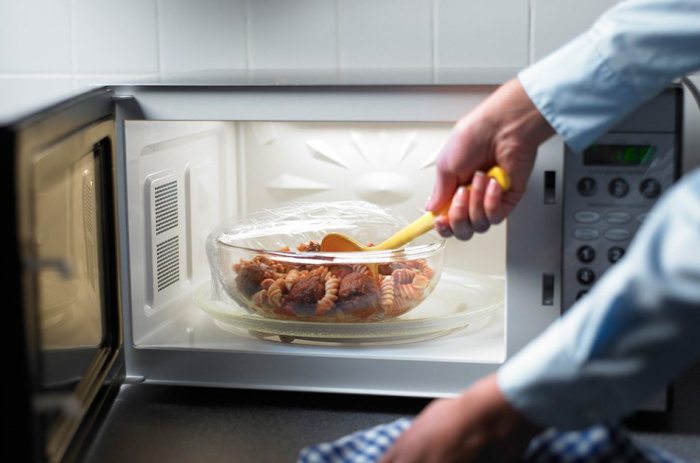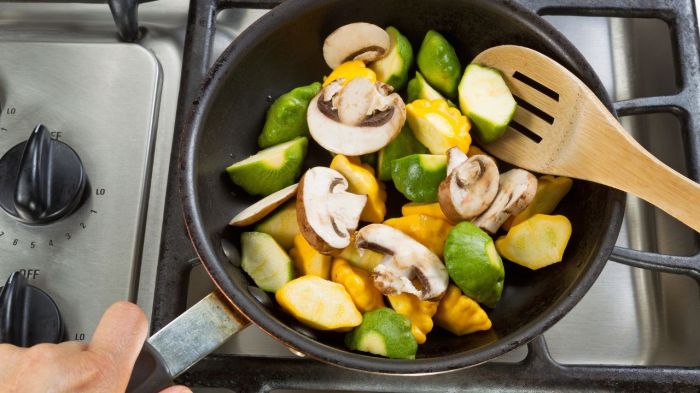Reheat Frozen or Chilled Food is crucial for both safety and deliciousness. Proper reheating prevents foodborne illnesses, ensuring your meals are not only enjoyable but also safe to eat. This guide will walk you through the best practices for reheating frozen and chilled foods, from safety considerations to specific reheating methods and equipment choices.
This comprehensive guide explores the various aspects of reheating, covering everything from understanding safe internal temperatures to choosing the right method for different foods. We’ll also delve into portion control, preventing food waste, and maintaining the quality and nutritional value of your reheated meals.
Safety Considerations: Reheat Frozen Or Chilled Food
Reheating frozen or chilled food is a common practice, but it’s crucial to do it safely to prevent foodborne illnesses. Improper reheating can create ideal conditions for harmful bacteria to multiply, leading to serious health problems. Understanding the risks and following safe practices is essential for protecting yourself and your loved ones.
Foodborne Illnesses Associated with Improper Reheating
Foodborne illnesses can arise from various pathogens that thrive in improperly reheated foods. These pathogens, such as Salmonella, E. coli, and Staphylococcus aureus, multiply rapidly in temperature danger zones. This multiplication leads to the production of toxins that cause symptoms like nausea, vomiting, diarrhea, and fever. The severity of illness can range from mild discomfort to severe complications requiring hospitalization.
Therefore, understanding and practicing safe reheating techniques is vital for food safety.
Importance of Using a Food Thermometer
A food thermometer is an indispensable tool for ensuring food safety during reheating. It provides an accurate measurement of the internal temperature, confirming that the food has reached a safe temperature to kill harmful bacteria. Relying solely on visual cues, such as the appearance of steam or warmth, is insufficient. Internal temperatures must be checked to guarantee that the food has been thoroughly heated throughout.
This ensures that the food is at a safe temperature to prevent the growth of harmful bacteria.
Safe Internal Temperatures for Different Food Types
The safe internal temperature for reheating various food types varies. This is because different types of food require different heating durations and intensities. Using the proper internal temperatures prevents the multiplication of harmful bacteria. The table below summarizes the safe internal temperatures for different food types.
Reheating frozen or chilled food is a simple process, but it’s crucial for safety. Proper reheating methods prevent foodborne illnesses, which can be as unsettling as the emotional turmoil explored in the fascinating article about “the twilight sad sick” the twilight sad sick. So, always remember to thoroughly reheat to a safe internal temperature before enjoying your meal.
| Food Type | Safe Internal Temperature (°F) |
|---|---|
| Ground meats (beef, pork, lamb) | 165 |
| Poultry (chicken, turkey) | 165 |
| Leftovers | 165 |
| Seafood (fish, shellfish) | 145 |
| Gravies, soups, stews | 165 |
| Eggs | 160 |
Preventing Bacterial Growth During Reheating
Preventing bacterial growth during reheating requires meticulous attention to detail. The initial temperature of the food, the reheating method, and the duration of reheating all play significant roles in controlling bacterial growth. Ensure that food is reheated thoroughly to the correct temperature to kill harmful bacteria. Microwaving, stovetop reheating, and oven reheating are all viable options, provided the safe internal temperatures are maintained.
Safe Reheating Methods
Safe reheating methods involve using appropriate cooking methods and paying attention to timing. Each method has its own characteristics, influencing the rate and evenness of heating. Microwave ovens, for example, often heat unevenly, so careful monitoring and stirring are crucial. Stovetop reheating allows for better control over the temperature, but proper stirring is still essential. An oven provides a uniform heat distribution, ideal for large quantities of food.
Thorough and consistent heating is key for food safety.
Methods for Reheating

Reheating food, whether frozen or chilled, is a crucial part of ensuring food safety and enjoyment. Proper reheating techniques maintain food quality and prevent potential health risks. The method you choose significantly impacts the final product’s texture, taste, and overall satisfaction. Different methods excel in different situations, so understanding their nuances is key.The key to safe and effective reheating lies in understanding the methods available and their specific strengths and weaknesses.
This will help you choose the best approach for various dishes and achieve the desired outcome.
Comparison of Reheating Methods
Different methods of reheating, such as microwaving, oven reheating, and stovetop reheating, offer distinct advantages and disadvantages. Factors like even heating, moisture retention, and the potential for dryness need careful consideration.
Microwave Reheating
Microwave reheating is a quick and convenient method. It works by exciting water molecules in the food, causing them to vibrate and generate heat. This method is generally efficient for smaller portions and dishes with a high water content.
- Pros: Speed is a significant advantage. It’s often the fastest method for reheating. Also, microwaves are energy-efficient when used appropriately, and they generally require less cleanup than other methods.
- Cons: Uneven heating is a common issue. Microwaves can cause hot spots and cold spots in the food, potentially leaving some parts undercooked while other parts become overcooked. Additionally, it can lead to the loss of moisture, resulting in dry food. It’s crucial to stir and rotate the food during reheating to promote even heating and to avoid dryness.
- Steps: Ensure the food is covered or in a microwave-safe container. Set the power level and time based on the food’s type and desired temperature. Stir or rotate the food during the process to ensure even heating. Check the temperature with a food thermometer to verify it has reached a safe internal temperature.
Oven Reheating
Oven reheating is a versatile method suitable for larger portions or dishes with various components. The even distribution of heat throughout the oven allows for a more consistent temperature throughout the food.
- Pros: Oven reheating is known for its ability to provide even heating throughout the dish. This is particularly useful for larger portions or dishes with multiple components, ensuring a consistent temperature across the entire item. It’s also more effective for reheating dishes that might dry out in a microwave. Moreover, the gentle heat helps retain moisture better.
- Cons: Oven reheating is generally a slower method compared to microwaving. It also requires more energy and cleanup than other methods.
- Steps: Preheat the oven to a safe temperature. Place the food on a baking sheet or in a covered dish. Reheat according to the food’s type and desired temperature. Use a food thermometer to ensure the food reaches a safe internal temperature.
Stovetop Reheating
Stovetop reheating provides precise control over the heating process, allowing for careful monitoring of temperature and ensuring even cooking. It’s a great option for sauces, stews, or dishes that need a gentle simmer to maintain their flavors.
- Pros: It offers precise control over the heating process, allowing for gentle warming and preventing overcooking. The slow, controlled heat is ideal for sauces and stews, helping to maintain their flavors and textures. You can adjust the heat as needed for optimal results.
- Cons: It’s a slower method compared to microwaving or oven reheating. It requires careful monitoring to prevent burning. Cleanup can be more extensive, depending on the dish.
- Steps: Place the food in a saucepan or skillet over low heat. Stir frequently to ensure even heating. Use a food thermometer to monitor the internal temperature and adjust the heat accordingly.
Reheating Suitability Table
| Food Type | Microwave | Oven | Stovetop |
|---|---|---|---|
| Pasta dishes | Suitable | Suitable | Suitable |
| Soups | Suitable | Suitable | Ideal |
| Stews | Suitable | Suitable | Ideal |
| Pizza | Suitable | Suitable | Suitable |
Food Preservation
Proper reheating is crucial not only for safety but also for maintaining the quality and nutritional value of frozen or chilled foods. Improper reheating can lead to a less desirable eating experience and potentially impact the food’s overall nutritional content. Understanding the delicate balance between reheating and food preservation is essential for ensuring that our meals are both safe and delicious.Reheating food, while necessary for safety, can also affect its texture and quality if not done correctly.
This process can lead to significant changes in the food’s structure, potentially compromising its nutritional value and palatability. Careful attention to methods and temperatures is essential to prevent these negative impacts.
Effects of Improper Reheating on Food Quality and Texture
Improper reheating can result in a variety of undesirable outcomes. Overheating, for example, can lead to toughening of meats, resulting in a dry and less appealing texture. Likewise, vegetables may become mushy or lose their crispness, significantly impacting the overall eating experience. These changes in texture can also alter the food’s taste, sometimes making it less enjoyable.
Relationship Between Reheating and Food Spoilage
The process of reheating can indirectly influence food spoilage. If reheating isn’t done to the correct temperature, it can create pockets of insufficient heat. These areas, while not immediately dangerous, may become breeding grounds for bacteria and microorganisms, increasing the risk of spoilage over time.
Strategies to Maintain Nutritional Value During Reheating
Careful consideration of reheating methods can help to preserve the nutritional value of foods. Minimizing the time food is exposed to high temperatures can help prevent the breakdown of vitamins and minerals. Using methods that maintain moisture, such as steaming or gently simmering, can also contribute to preserving nutritional value.
Common Mistakes to Avoid When Reheating Food
- Overheating: Foods should not be reheated to the point of burning or becoming dry. Overheating can alter the taste and texture, leading to a less desirable eating experience.
- Uneven Heating: Ensure that food is heated thoroughly throughout. Using a microwave, for example, requires careful stirring to distribute heat evenly.
- Reheating Leftovers Multiple Times: Reheating leftovers more than once can reduce the food’s safety and quality. It’s best to plan meals that use up leftovers in a single sitting.
- Insufficient Heating Time: Foods must be reheated to a temperature that effectively kills any harmful bacteria. Insufficient heating time can pose a safety risk. Use a food thermometer to ensure that the food reaches a safe internal temperature.
- Using Incorrect Equipment: Certain types of cookware may not be suitable for reheating specific foods. Using the wrong equipment can affect the texture or result in uneven heating.
Preventing Food Waste
Reducing food waste is crucial for environmental sustainability and personal savings. Proper portioning and meal planning are key strategies for minimizing the amount of reheated food that ends up in the trash. By understanding how much to cook and how to use leftovers effectively, we can make a significant impact on our waste footprint.
Portioning Frozen or Chilled Food
Careful portioning is essential to avoid overcooking or discarding perfectly good food. Determine the exact amount of food you need for each meal to prevent excess. Using freezer containers or airtight storage bags can help keep food fresh for future use. Proper labeling and dating of containers will help you keep track of your inventory. For example, portioning individual meals into containers before freezing allows for easy reheating and avoids the need to defrost an entire package.
Determining Correct Portion Sizes for Reheating
Knowing the right portion size for reheating is crucial for minimizing waste and ensuring optimal temperature. Consider the serving size of each dish. Larger portions may require longer reheating times, potentially leading to dryness or overcooking. For instance, a larger portion of lasagna might require a longer time in the oven or microwave to ensure thorough heating without burning.
Smaller portions heat more quickly and efficiently, preserving the texture and flavor of the food.
Planning Meals Around Reheating Leftovers
Strategic meal planning can dramatically reduce food waste by incorporating leftovers into future meals. Review your weekly menu and identify potential leftovers. Plan meals around these leftovers to avoid unnecessary waste. For example, leftover roasted chicken can be used in salads, sandwiches, or soups for future meals. Similarly, leftover rice or pasta can be used as a base for a quick and easy stir-fry or a flavorful pasta dish.
Portion Size Table for Different Reheating Methods
| Reheating Method | Portion Size Recommendation (Example) | Considerations |
|---|---|---|
| Microwave | 1-2 servings of pasta, 1-2 portions of soup | Smaller portions heat more quickly and evenly, preventing dryness. |
| Oven | 2-3 servings of lasagna, 2-3 portions of casserole | Larger portions may require longer heating time, potentially leading to uneven heating. |
| Stovetop | 2-3 servings of stew, 2-3 portions of chili | Control heat carefully to prevent burning. Consider using smaller pots for even heating. |
| Air Fryer | 1-2 servings of chicken, 1-2 portions of vegetables | Adjust cooking time based on the thickness and type of food. |
Reheating Specific Food Types
Reheating leftovers is a crucial part of responsible food management. It allows us to enjoy delicious meals without compromising safety. However, different food types require specific techniques to maintain their quality and texture, and more importantly, to ensure they are thoroughly heated to prevent foodborne illnesses. This section dives into the optimal reheating methods for various foods, emphasizing safety and preservation.
Reheating frozen or chilled food can be tricky, especially if you’re aiming for a perfectly cooked meal. Sometimes, though, the problem isn’t the reheating method itself, but the cookware. Have you ever wondered why your new disposable container seems to burn the food? Check out this helpful article on Why Does My New Disposable Taste Burnt to troubleshoot potential issues with your cooking.
Regardless of the source of the burnt flavor, proper reheating techniques are key to delicious results, so don’t let a little burnt taste ruin your meal!
Optimal Reheating Methods for Different Food Types
Proper reheating methods are vital for preserving the nutritional value and taste of food. Different foods respond differently to heat, and improper techniques can lead to dry, mushy, or even unsafe meals. Understanding the ideal method for each food type is essential for maximizing enjoyment and minimizing food waste.
Reheating frozen or chilled food is a pretty straightforward process, but it’s important to do it safely. Sometimes, though, I find myself reflecting on how beautiful people are in their sleep, unaware of their own grace, like in the song i like it when you sleep for you are so beautiful yet so unaware of it. It’s almost like a little reminder to savor the simple act of reheating leftovers and appreciating the deliciousness of a warm meal, no matter how mundane it might seem.
- Vegetables: Vegetables generally benefit from a gentle reheat. Steaming or microwaving in short bursts are excellent choices. Avoid boiling, as it can make them overly mushy. Add a splash of broth or water if needed to prevent them from drying out.
- Meats: Meats should be reheated to a safe internal temperature to eliminate harmful bacteria. Oven reheating or stovetop methods are suitable. Ensure the internal temperature reaches at least 165°F (74°C). Using a meat thermometer is highly recommended for accurate temperature checks.
- Pasta: Pasta is best reheated by adding it to a pan with a little broth or water. Stirring continuously will help prevent sticking and ensure even heating. If reheating in the microwave, ensure it is evenly coated in liquid to prevent drying out. A simple sauce addition can make a big difference.
Detailed Procedure for Reheating Lasagna
Reheating lasagna can be tricky, but following these steps can ensure a delicious and safe result.
- Preparation: Preheat oven to 350°F (175°C). Carefully remove the lasagna from its container.
- Even Heating: If the lasagna is in a baking dish, you can cover it with foil to prevent drying. Ensure the dish is placed in the center of the oven for even heating.
- Reheating Time: Heat for 20-30 minutes, or until heated through and bubbly. A good rule of thumb is to use a meat thermometer and check the internal temperature of the lasagna, ensuring it reaches at least 165°F (74°C).
- Checking for Thoroughness: Check the center of the lasagna to ensure it’s thoroughly heated throughout. If necessary, reheat in shorter intervals, checking the temperature regularly.
Challenges of Reheating and Solutions
Several challenges can arise during reheating, and these solutions can prevent undesirable outcomes.
- Drying Out: Vegetables and meats can dry out easily during reheating. Adding a little liquid, such as broth or water, to the dish can help retain moisture. Covering the dish during reheating is also beneficial.
- Uneven Heating: Uneven heating can result in some areas being undercooked while others are overcooked. Stirring or rotating the dish during reheating helps ensure even heat distribution. Using the right method for the specific dish (e.g., oven, stovetop) also helps with even heating.
- Loss of Flavor: Flavor can diminish if reheating isn’t done correctly. Adding a touch of seasoning or sauce can help restore the original taste and enhance the flavors during the reheating process.
Ideal Reheating Methods Table
This table provides a quick guide to the ideal reheating methods for various food categories.
| Food Category | Ideal Reheating Method |
|---|---|
| Vegetables | Steaming, microwaving |
| Meats | Oven, stovetop |
| Pasta | Stovetop, microwave |
| Casseroles | Oven |
| Soups | Stovetop, microwave |
Equipment Considerations

Choosing the right equipment for reheating food is crucial for both safety and efficiency. Improper equipment can lead to uneven heating, potential foodborne illnesses, and even damage to your appliances. Understanding the specific needs of different reheating methods and food types is key to maximizing safety and minimizing waste. From microwaves to stovetops, the right tools make all the difference.Selecting the appropriate cookware or containers is essential for successful reheating.
This includes ensuring the container is suitable for the chosen reheating method and the type of food being reheated. Different materials react differently to heat, and some materials may leach chemicals into food if exposed to high temperatures.
Microwave-Safe Containers
Microwave-safe containers are specifically designed to withstand the high-frequency radiation used in microwaves. They are typically made of materials like ceramic, glass, or microwave-safe plastic. These materials distribute heat evenly, preventing hot spots and ensuring food is heated thoroughly. Avoid using metal containers in a microwave, as they can cause sparks or damage the appliance. Ensure that the container is suitable for the specific food item and the reheating method being employed.
Stovetop Reheating
When reheating on the stovetop, using appropriate cookware is vital. Stainless steel cookware is a popular choice due to its durability and even heat distribution. Cast iron also works well but can take longer to heat up. Non-stick cookware is often used for delicate foods, but it’s crucial to avoid using excessively high heat, as this can damage the non-stick coating.
Heavy-bottomed pots and pans provide better heat retention, which is particularly helpful for soups and stews.
Oven Reheating
For oven reheating, select baking dishes that are oven-safe and suited to the food’s characteristics. These may be made of ceramic, glass, or metal. Consider the size and shape of the dish in relation to the food’s volume. Ensure the dish is appropriate for the oven’s temperature and doesn’t warp or crack under heat. If you are reheating a dish in a roasting pan, make sure the dish is large enough to prevent overcrowding and uneven cooking.
Selecting the Correct Cooking Setting
Choosing the correct cooking setting is crucial for efficient and safe reheating. Microwave settings vary, and incorrect settings can lead to uneven cooking or potential hazards. Stovetop temperatures must be adjusted according to the food’s consistency and the type of cookware being used. Oven temperatures should be pre-set according to the manufacturer’s instructions and the specific recipe or reheating guidelines.
For example, reheating a pizza in the oven might require a lower temperature than reheating a casserole.
Key Features of Reheating Equipment
When choosing reheating equipment, consider these key features:
- Even Heating: Look for equipment that distributes heat evenly to prevent hot spots and ensure thorough cooking. This is especially important for foods that have different densities or thicknesses.
- Temperature Control: Precise temperature control is essential for safe and effective reheating. This is critical to prevent foodborne illnesses.
- Ease of Use: Choose equipment that is easy to clean and maintain. A user-friendly interface can minimize the risk of errors during the reheating process.
- Durability and Safety Features: Select equipment made from high-quality materials that can withstand regular use. This includes features like automatic shut-off or safety locks to prevent accidents.
- Capacity: Consider the capacity of the equipment relative to the amount of food being reheated. Overcrowding can lead to uneven heating.
Specific Requirements for Different Reheating Methods
Different reheating methods have specific requirements that must be followed to ensure food safety and quality.
- Microwave: Use microwave-safe containers and avoid overcrowding. Stir food halfway through the reheating process to ensure even heating. Check the food’s temperature using a food thermometer.
- Stovetop: Use appropriate cookware and ensure the heat is controlled. Stir constantly to prevent burning or sticking. Avoid overheating the food.
- Oven: Use oven-safe dishes and set the temperature according to the food type and desired result. Allow adequate time for the food to reheat evenly.
Portion Control and Leftovers
Leftovers are a fantastic way to save time and money, but proper handling is crucial for both safety and taste. Knowing how to store and reheat leftovers correctly ensures they remain delicious and prevent foodborne illnesses. This section will delve into best practices for storing leftovers, preventing cross-contamination, and reheating them effectively.
Storing Leftovers Safely
Proper storage is paramount to preventing bacterial growth and maintaining food quality. Leftovers should be cooled quickly and stored at the correct temperature to inhibit the growth of harmful microorganisms. Immediately transfer food to airtight containers or wrap them tightly in plastic wrap or foil. The key is to minimize the surface area exposed to air and bacteria.
Preventing Cross-Contamination
Cross-contamination is a significant risk when handling leftovers. Use separate utensils and cutting boards for raw and cooked foods to avoid transferring bacteria from one to the other. Ensure that the containers used for storing leftovers are clean and free of any residue that could harbor harmful bacteria.
Reheating Leftovers Safely, Reheat Frozen or Chilled Food
Reheating leftovers to the correct internal temperature is critical for eliminating any harmful bacteria that may have grown during storage. Use a food thermometer to ensure that the food reaches a minimum internal temperature of 165°F (74°C). Avoid reheating leftovers multiple times. If reheating leftovers multiple times, you may have issues with quality and safety.
Storage Methods and Reheating Potential
| Storage Method | Storage Time (Refrigerator) | Reheating Potential | Notes |
|---|---|---|---|
| Airtight Containers | 3-4 days | Excellent | Ideal for most leftovers. Ensures food is well-sealed. |
| Plastic Wrap/Aluminum Foil | 3-4 days | Good | Efficient for smaller portions. Ensure tight wrapping to prevent leakage. |
| Glass Containers | 3-4 days | Excellent | Safe and reusable. Ideal for larger portions and microwave reheating. |
| Reusable Food Storage Bags | 3-4 days | Good | Convenient for some foods, but may not be as airtight as other options. |
Proper reheating of leftovers is vital to prevent foodborne illness.
Ultimate Conclusion
In conclusion, reheating food safely involves more than just quickly warming it up. By understanding the risks of improper reheating, choosing the right method for different foods, and practicing proper portion control, you can enjoy delicious and safe meals while minimizing food waste. Remember, a little attention to detail goes a long way in ensuring a healthy and satisfying experience with reheated foods.




